
Is having a disorganized home such a big deal? Why not let people live how they want to live?
Having a clean, comfortable home affects people in different ways:

Keeping a clean, organized home is well worth all the physical, mental, emotional, and social benefits that come with it.

From sleep quality to infection control, cleanliness affects how well your body functions from day to day.
Here are a few ways keeping an orderly environment can help you physically:
Keeping a clean home reduces the risk of illness-causing pathogens being passed to residents of the home.
Food preparation areas should be sanitary, especially after handling raw meat.
Bathroom areas should be cleaned regularly, and animal waste should be taken care of to prevent disease.
People with cluttered homes are more likely to experience insomnia. It’s hard to know if it stems from increased stress levels, difficulty getting comfortable in a cluttered space, or from another cause, but cleaning up clutter should help you get a better
night’s sleep.
Allergies and asthma attacks can be triggered by dust, pet hair and dander, and mold. Keeping homes free of these triggers can improve allergy and asthma symptoms.

The state of your home can have profound effects on your mental state. A cluttered, disorganized space can stress and overwhelm us. Severely cluttered homes can also cause feelings of shame and anxiety. Here are a few ways keeping your home in order can help you function well mentally:
A clean, uncluttered space helps our minds stay on task without distraction. When we see more items in our line of sight, it can actually slow down our brain’s processing speed and make it more difficult to focus.
When we constantly look around us and see work that needs to be done, it’s difficult to feel calm. How can we relax when we’re surrounded by chaos? Maintaining a clean, organized space will create tranquility and peace-of-mind.
Setting your home in order can be empowering! When you are able to make your space look and feel the way you want it to be, you feel a sense of accomplishment.
When your home is constantly in good condition, you can depend on it as a place to relax and feel at peace. Regardless of what happens outside your home, you have a refuge where you can retreat from the world.
Creativity needs margin and blank space to grow. When your space is not distracting from your thought process, your brain can focus on new ideas.

Just as tasks requiring deep thought can be difficult when our homes are chaotic, our emotions can also be hard to settle when our environment is in upheaval. Here are some emotional benefits to improving the cleanliness of your home:
When you’re in a clean, comfortable environment, you feel better emotionally. Many studies show a relationship between messy homes and unhappiness.
Not only does being in a clean, restful environment contribute to being better able to focus and be mindful, the act of cleaning itself actually offers an opportunity to practice mindfulness. Being mindful of the task at hand can decrease feelings of anxiety and increase feelings of inspiration.
Emotional regulation is the ability to respond to your emotions mindfully. This skill can help you reframe negative emotions and cope with stress. When your home is less cluttered, you are better able to attend to your emotions and find peace.

Your home doesn’t only affect you—it also has an effect on the people around you. When your home is messy and disorganized, it can actually hinder your relationships. Here are some ways cleaning and organizing can benefit you socially:
Cleaning up can create a welcoming space for you to spend time with those you care about. When your home is messy and disorganized, it can be difficult, or even embarrassing, to host others.
You may feel embarrassed about the state of your home, or your friends may not be comfortable there due to cleanliness issues, a lack of seating due to spaces being taken up by clutter, and so on.
When your home is clean and uncluttered, there is space for family to come and stay. Even if you need to set up cots or sleeping bags to accommodate extra guests, they can still be comfortable with you. With a clean floor and stored belongings, this can become a reality.
In severe cases, disorganization and lack of cleanliness can lead to structural issues with your home. Appliances may fall into disrepair and become hazardous, or the home’s structure can even be compromised by the weight of your belongings.
When your things are in order, there is no danger of needing to relocate. However, when your things are in order, there is no danger of being forced to relocate. That stress is non-existent. At a certain point, a health inspector could become involved.

Everyone can improve the state of their homes—we all struggle to keep things clean and hang on to only the possessions we really need.
However, when we take the necessary steps to tidy up and declutter, we can see benefits in many different areas of our lives: physically, mentally, emotionally, and socially.
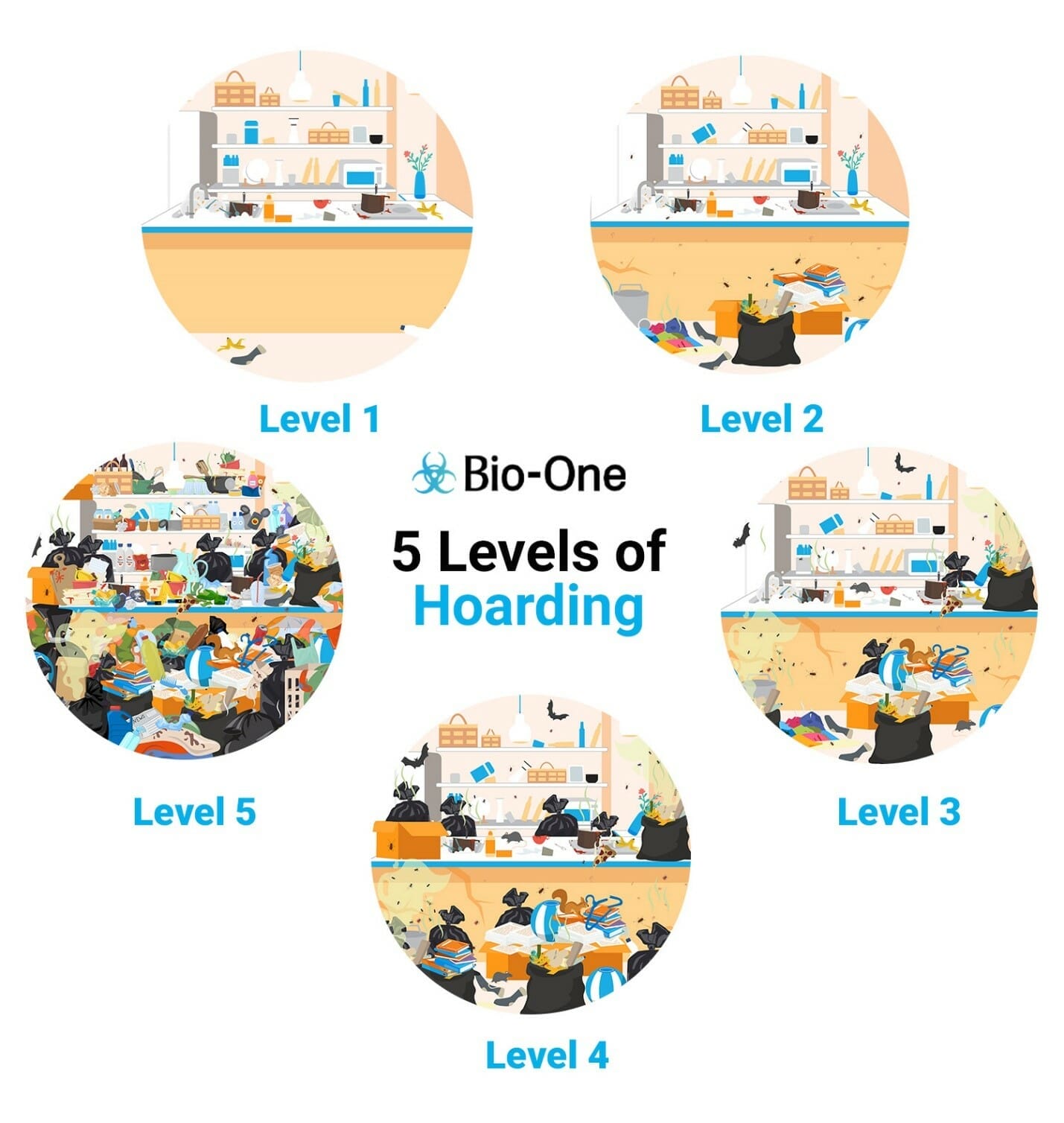
The word “hoarding” probably evokes a particular image, made more common by shows like Hoarders that highlight extreme examples. In reality, not all hoarders have rooms full of items piled high to the ceiling.
The Institute for Challenging Disorganization (now, there’s a relatable title!) has classified hoarding behavior into five levels on their Clutter-Hoarding Scale.Level 1 Hoarding
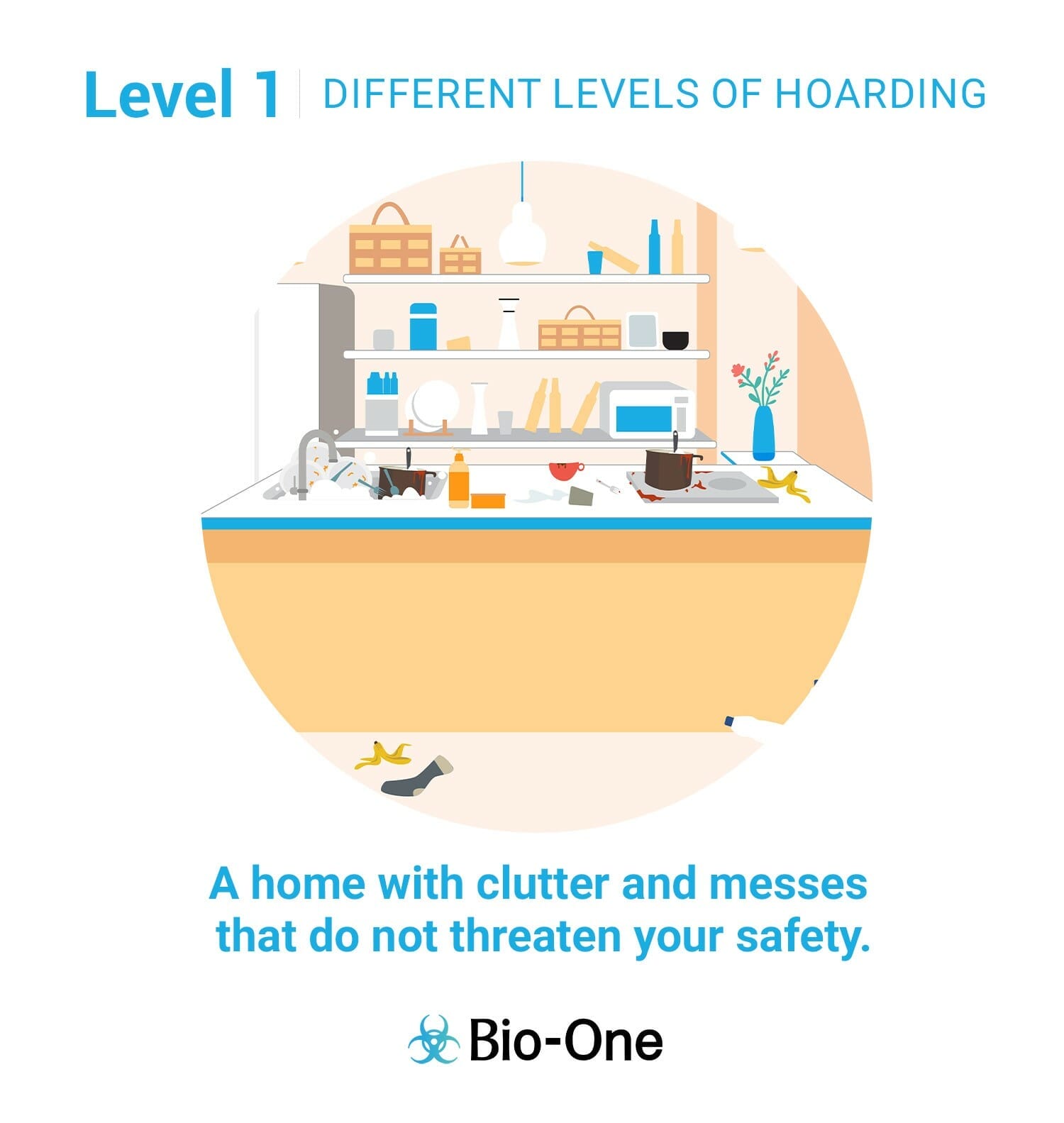
At Level 1, a home is not pristine, but the space is still easily accessible and sanitary. There is clutter, but no concern for safety. Most, if not all of us, have been in Level 1. Many people spend most of their time in this stage.
Here are the defining characteristics of this level:
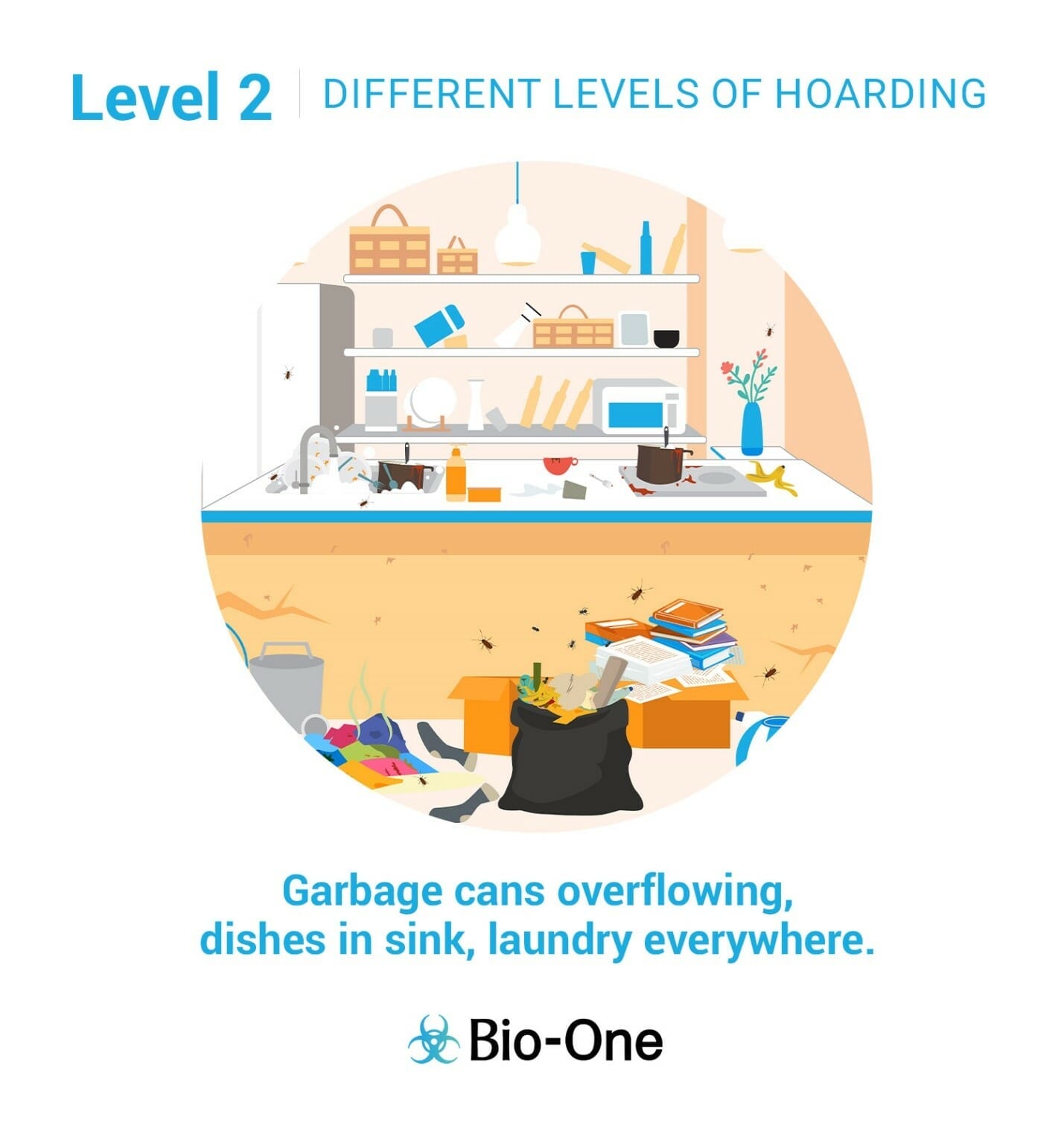
At Level 2, the home is still very livable, but there’s more evidence of disarray. The home is in need of cleaning and may be starting to overwhelm the residents. The hygiene level isn’t optimal.
Most of us bounce between Level 1 and Level 2. However, here are the more defining characteristics of Level 2:
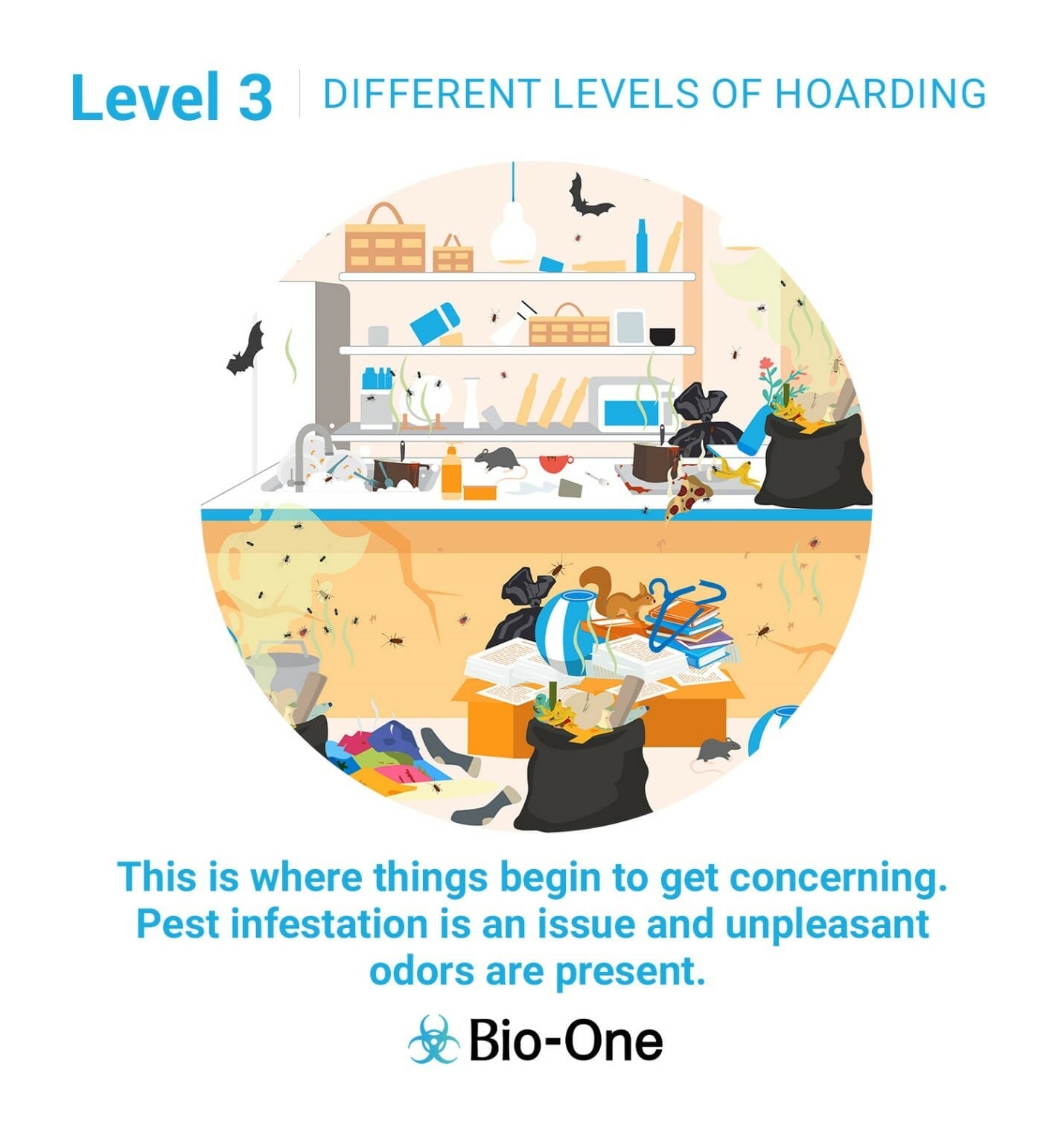
Level 3 is considered the turning point between manageable household disorganization and a more serious issue. Level 3 homes show extreme disorganization and indicate hoarding behavior.
Here are the defining characteristics of this level:
Level 3 households should consider hiring outside help. Although, it’s still possible to get it under control with a concerted effort from the whole family
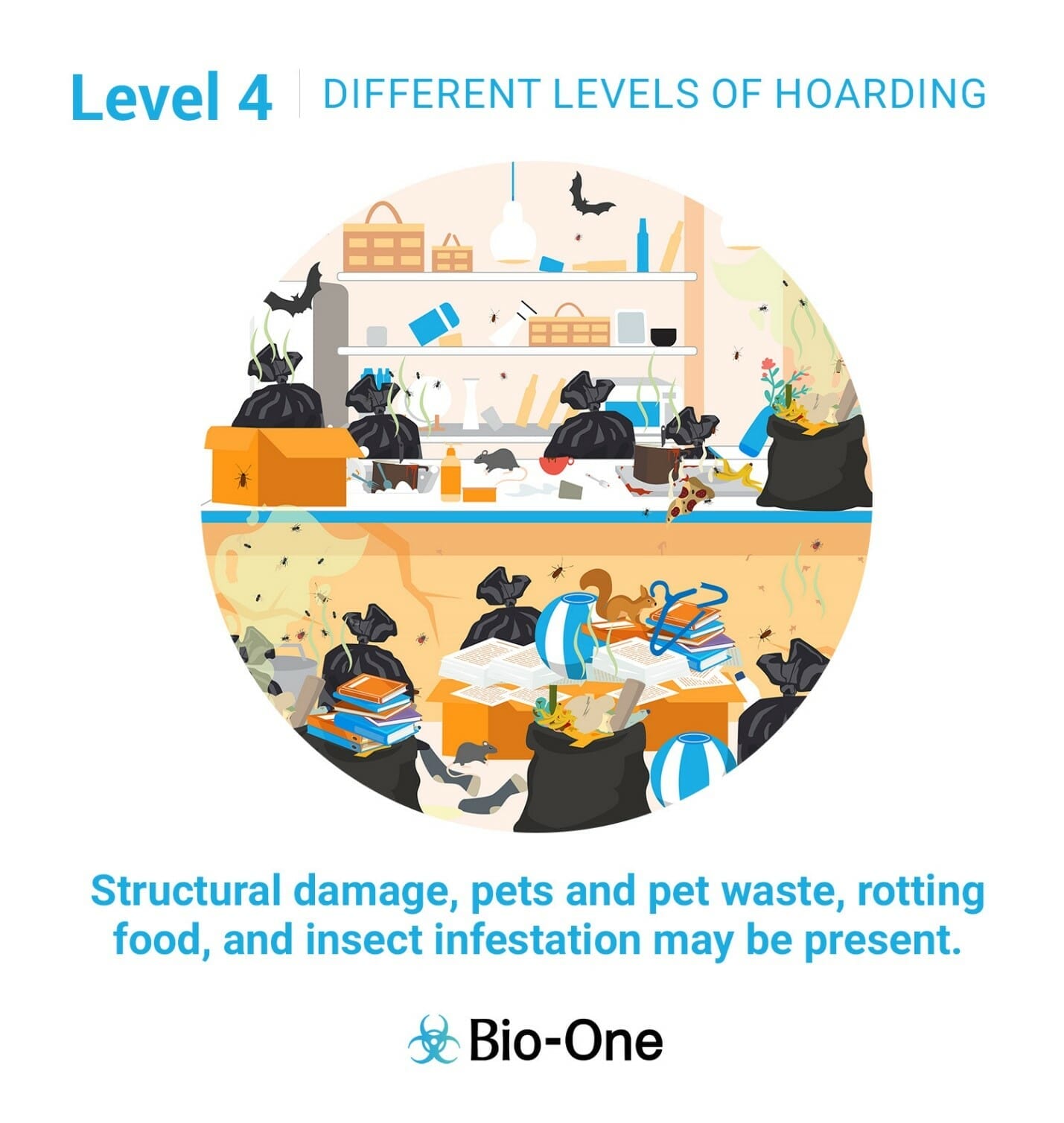
At Level 4, the home shows excessive clutter.Those living in Level 4 conditions need professional help. At this level, part of getting help includes professional cleaning to transform the house into a safe, hygienic space where people can thrive. Mental health counselors and social workers may also step in to help residents change their habits.
Here are the defining characteristics of this level:
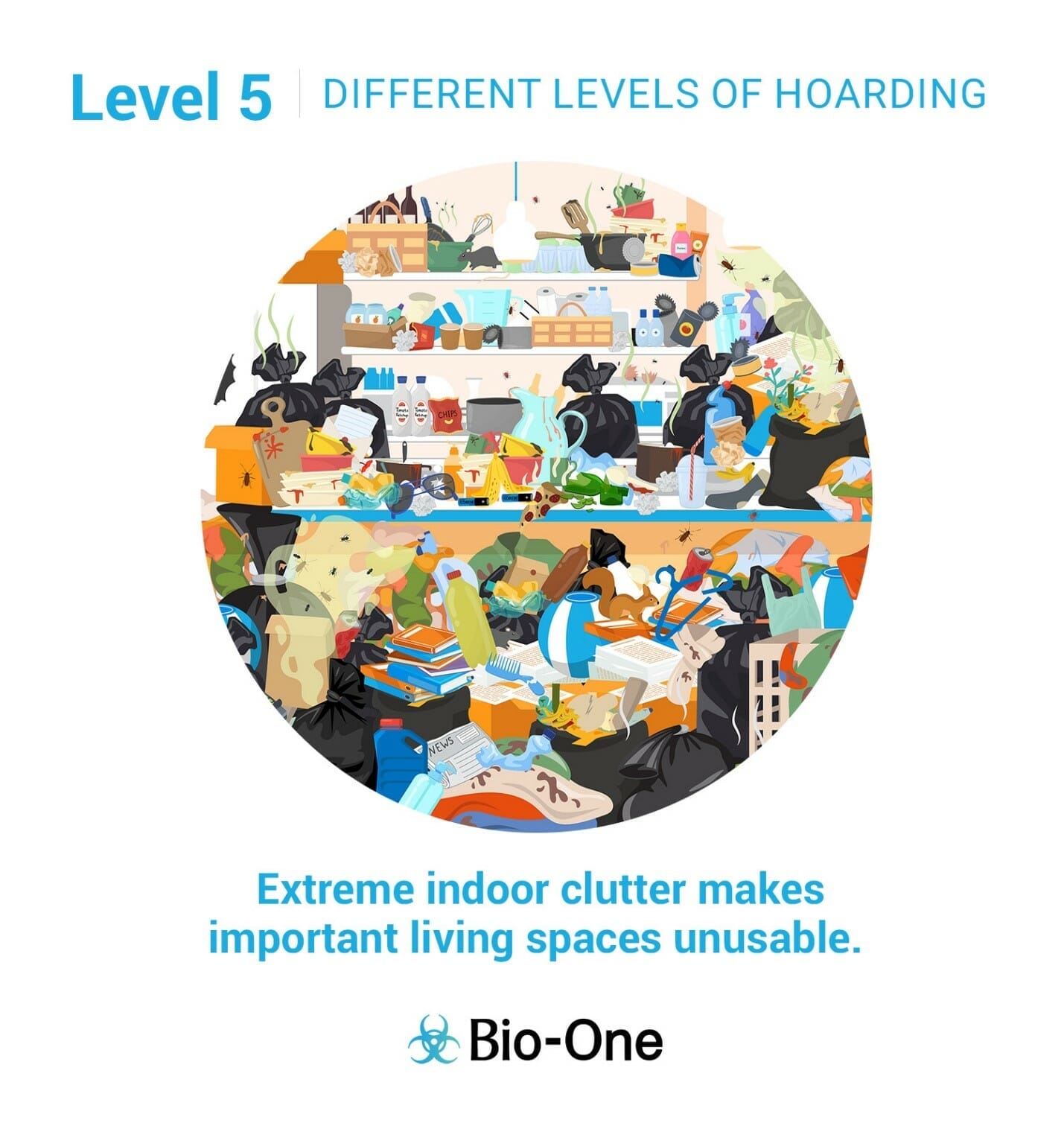
Level 5 is the highest level of hoarding behavior. Level 5 homes are alarmingly hazardous.
They require professionals with safety equipment and training to clean.
Here are the defining characteristics of this level:
If you or someone you know is struggling with these levels of hoarding we are here to help.
You can find more information at https://bioonesacramentoca.com/ or contact us at (916) 833-2461
Clutter is an everyday occurrence and there comes a point when we all need to clean up our messes. Leave things long enough, and we all start to fall into one of the 5 levels of hoarding.

But what are the 5 levels of hoarding?
What moves a messy room from Level 2 to Level 3?
Understanding the hoarding level of your space can help you prioritize which messes are one-person tasks and which may need some help from a back-up team.
Let’s walk through each level of the Institute for Challenging Disorganization’s Clutter-Hoarding Scale to better understand just how normal hoarding is.
There’s no doubt that many of us would like our homes to look as pristine as a real estate listing ad. But life’s hectic! With busy work and family schedules, numerous responsibilities and obligations, and competing priorities it’s easy to put off a small mess for later. However those moments of procrastination stack up to put our home at a Level 1.

Signs of this level of hoarding include clutter and messes that do not threaten your safety:
Ok, that last one MIGHT be dangerous if you’re barefoot.
None of these messes block exits in your home, and they do not cause an immediate bad odor. If we’re honest, we can admit that all of us—at one point or another—have had our home come in on this level of the hoarding scale.
Leaving your house in this state does not necessarily affect your health.
However, it may exacerbate avoidance habits that lead to snacking and more procrastination—which might lead to more clutter, shifting you up the scale.
This is another common level of hoarding. Most of us frequently bounce between Level 1’s clutter and Level 2’s disarray.

At this level, things literally begin to stack up:
At Level 2, the clutter can begin to impact a variety of areas of our lives. Some studies claim intense clutter increases our stress, makes allergies worse, and overall causes us to feel less satisfied with life.
These negative impacts are sometimes the trigger that leads to the situation getting worse.
Level 3 is where things begin to get concerning.

At this point, the mess itself may seem too daunting to tackle, and the increase in clutter results in a decline of cleanliness. There may be piles of objects obstructing multiple exits—or even a whole room used for storage instead of living.
It’s at this stage that pest infestations may become an issue. With the clutter, there are lots of places for unwelcome pests to hide and find food, and infestations of ants, lice, and cockroaches may warrant an exterminator. However, all that clutter makes it difficult for the exterminator to do a good job. Unfortunately, failing to clean up the source may set the stage for another infestation within a few weeks.
Another area of concern may be repairs needed around the home. Work may need to be done, but technicians or repair personnel may not be able to physically get to whatever needs to be fixed. This means small problems may become large ones as minor repairs are left to turn into bigger problems.
This state of things deeply impacts your ability to socialize. Messy and infested living spaces make it difficult to relax with your partner or family. Friends may prefer to outright avoid hangouts at your home. Your loved ones may be concerned about your living situation at this point.
The longer your home sits at Level 3, the higher the chance that leftover messes become long-term damage.
Hygiene and safety take a backseat in a house at Level 4. Long-term spills and messes create bad smells, and much of the house cannot be adequately used for each room’s purpose.

Those whose homes fit this category face daily irritation and inconvenience, all of it eventually leading to high repair bills, tripping hazards, and health hazards.
You may not think tripping hazards are a big deal, but falling over them certainly can be. Depending on how high the stacks are, they could even fall on you and do some damage that way.
There have been well documented cases where people have become trapped in their own home due to tripping hazards. Don’t let that be you!
Health hazards stack up in level 4 almost as quick as the clutter does. Issues like water damage that can no longer be reached lead to structural decay. Larger pests like bats or rodents may make their nests in the attic or basement and contribute to higher possibilities of disease.
A person or family living in this state may find it difficult to be comfortable doing anything.
Tackling the job to get the home back to a healthy and safe state may seem impossible on their own.
This is often what people think of when discussing hoarding behaviors. The situation may be the result of a psychological hoarding disorder or difficulty due to disability. It may have been compounded by depression or generational trauma or habits. The contributing factors are nuanced, varied, and often highly personal.

But whatever the reason, a Level 5 household is in need of serious, professional help.
Those in a Level 5 house live in outright unsafe conditions. On the daily they are coming in contact with:
Not only is it difficult to socialize with others in your home, you may find it difficult to even leave because of the sheer volume of things in the home and the blocked entryways.
Many who are at this stage find themselves disconnected from reality in a number of ways:
At this stage, the structural damage to the home is often irreparable and fire hazards begin to enter the picture.
Houses at level 5 are prone to fires because of the flammable piles of clutter. If a flame were to spark anywhere, it could easily catch something and spread from there.
Not only that, but it’s very difficult for firefighters to enter. If a fire were to start there’d be little to no way of stopping it. With so many flammable objects and no way to enter the home, all it can do is burn.
So how did your home do? Do you have an idea of where your home fits on the hoarding scale? The vast majority of us are on there somewhere, and the good news is that no matter the level your home scores, there is always help available.

After walking through all 5 levels of hoarding, it’s clear we all struggle with cleaning up the house sometimes. There’s nothing wrong with a messy house. It’s a part of normal, everyday life.
However, your health and safety are important, particularly when things advance to those higher levels. When facing a daunting clean-up, here’s quick tip for each level of hoarding:
Your home falls into one of these levels—just like everyone else’s! The next step is determining what you need to get back to a manageable Level 1.
Our team at Bio-One understands messy homes, and we’re here to offer discreet, compassionate help when you or a loved one is trying to dig out from a higher level mess. We offer affordable, professional services that include cleanup, disinfection, and decontamination.
Every job has a unique remediation plan tailored to the specific needs and goals of the client. Rest assured, wherever you may fall on the levels of hoarding, we have the experience and equipment necessary to help you.
Consult with our team today to discuss your situation and determine how much time you can save with professional help.
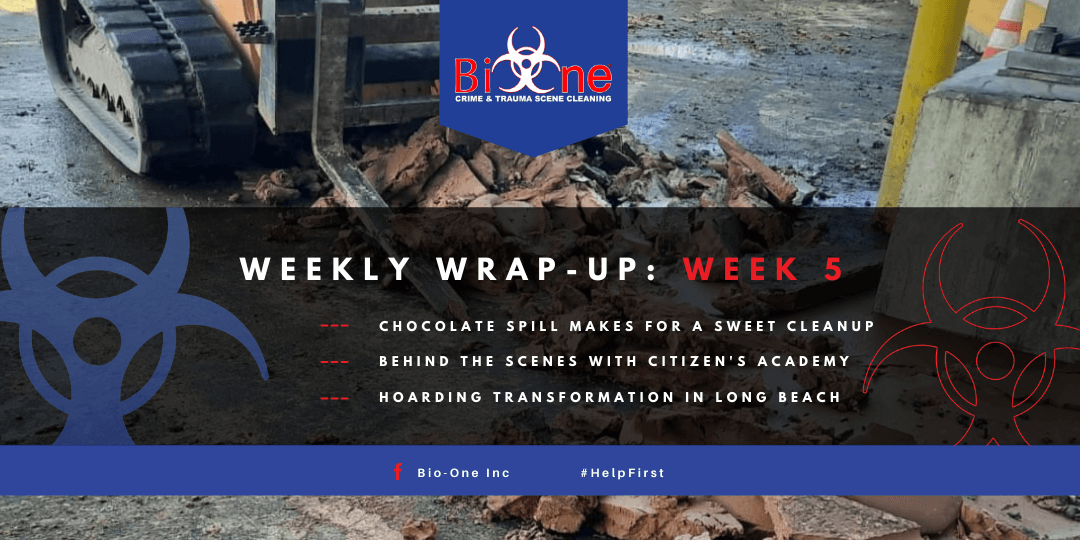
Bio-One teams across the U.S. answer calls to help their communities and remediate a variety of scenes. In our new blog series, we'd like to bring you into the Bio-One world by sharing stories of the unique and important work we do for local communities.
Here is Week 5 of our Bio-One Weekly Wrap-Up.
Chocolate Spill Makes for a Sweet Cleanup
In Scranton on March 25, Juan and Nicole Morales received a call for a "chocolate" cleanup. Assuming this was code for a sewage back-up, they rushed to scene to find a different situation entirely. Approximately 100 gallons of milk chocolate had spilled, covering asphalt outside a local business.
This is certainly the sweetest smelling job a Bio-One office has ever taken, but Nicole clarified, "That smell was nice for the first few minutes but at the end I felt sick. Good thing we had an awesome team that pushed through and got this done!"
After scraping the chocolate with a forklift and pressure washing the area, the Bio-One team received a five-star review. Well done!
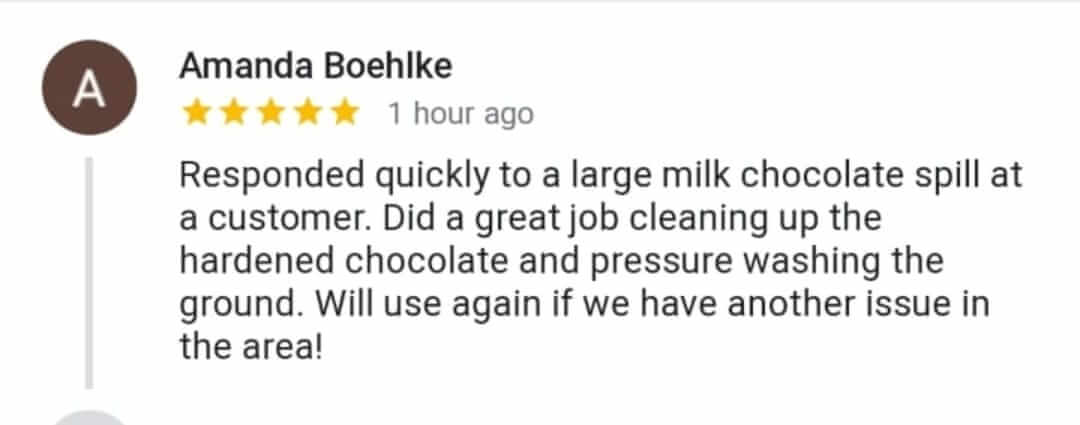
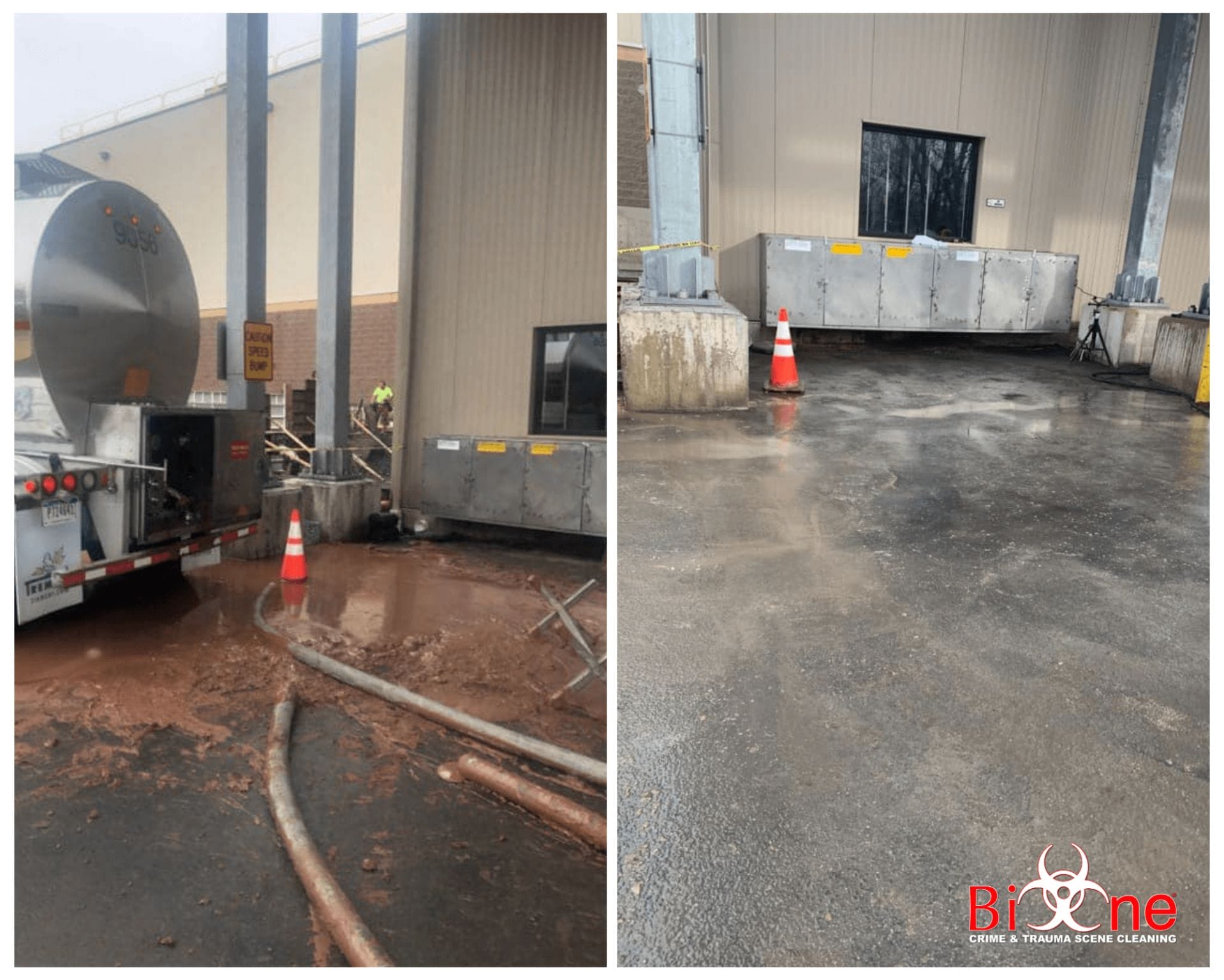
Behind the Scenes with Citizen's Academy
Many Bio-One owners sign up for their local Citizen's Police Academy to acquaint themselves with the activities of their local police department. This week, Bio-One owner, Ginger Akemon, in Jacksonville, FL earned her Citizen's Police Academy certificate from the Clay County Sheriff's Office.
"Definitely a learning process. Each County has their own, my goal is to go to each county's classes. This was 10 weeks long and over an hour drive each way, but well worth it, " said Ginger.
Hoarding Transformation in Long Beach
In Long Beach, the Bio-One team has been working hard on several hoarding projects. These before and after pictures show the detail and expertise our teams bring to each job.
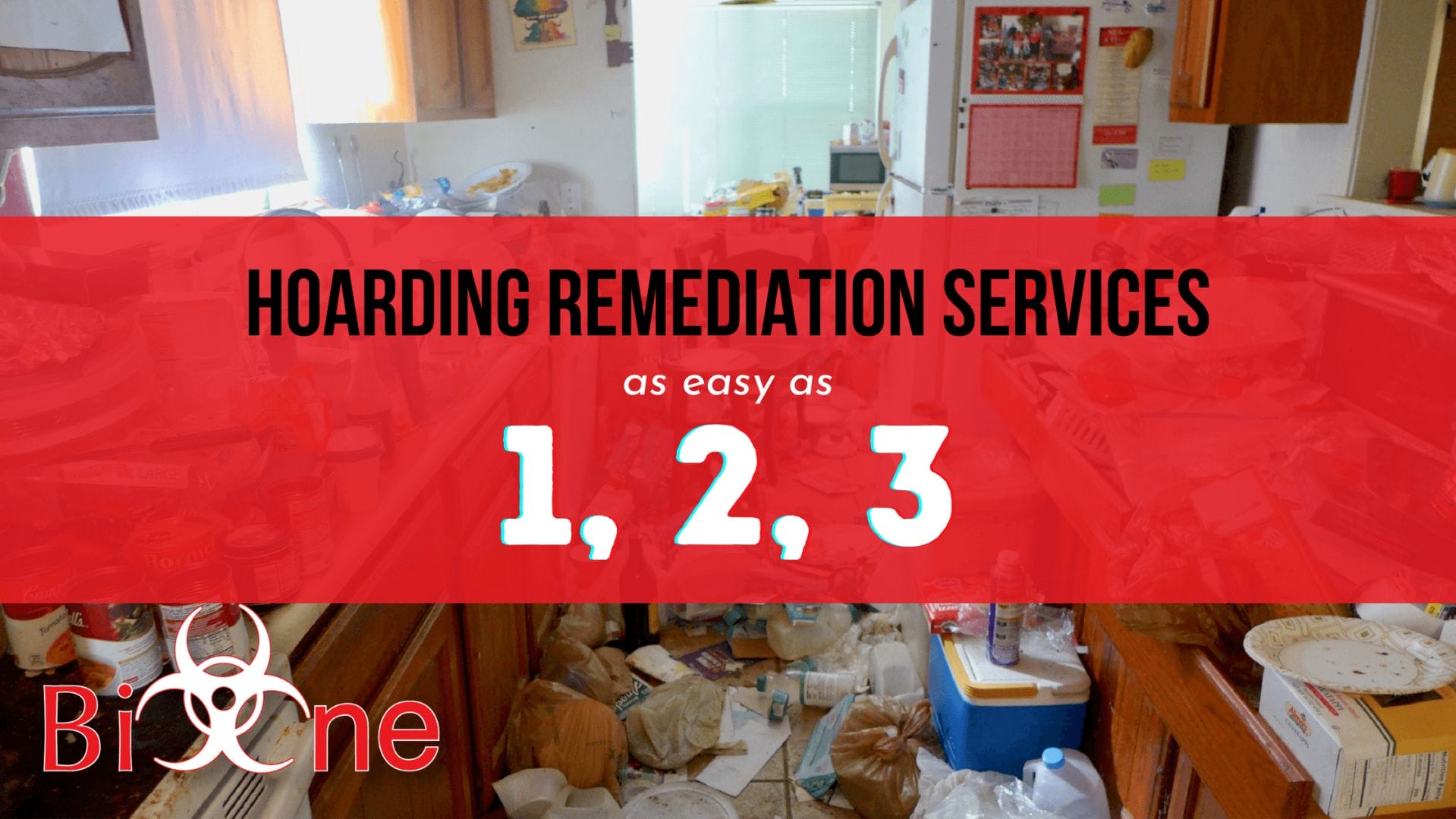
Have you ever seen hoarding shows on TV? Our team has first-hand experience remediating these situations with care and compassion. From clutter, trash, to animal hoarding, we understand that the removal of items can be stressful and sometimes overwhelming for families involved. Bio-One will make it a priority to establish trust to ensure everyone is comfortable and ready for each day to begin.
It's as simple as 1, 2, 3.
First, we always offer estimates at no cost to you. An experienced crew leader will tour the home and propose a plan based on your needs, expectations, and goals.
Second, our certified technicians are trained to be mindful of all possessions. We make it a priority to find and save items of value whether that's a wallet, coin collections, legal documents, photo albums, or baseball cards.
Third, we want to make sure you are 100% satisfied and happy with our work. If for some reason something else needs to be done, we are here for you.
Call Bio-One today to learn how we can help.

Bio-One teams across the U.S. answer calls to help their communities and remediate a variety of scenes. In our new blog series, we'd like to bring you into the Bio-One world by sharing stories of the unique and important work we do for local communities.
Here is Week 4 of our Bio-One Weekly Wrap-Up.
New Start for New Haven Veteran
In New Haven County, Bio-One and Junkluggers answered the call to help a veteran and his disabled wife. The couple were overwhelmed with a hoarded home and much of their furniture would need to be disposed due to biohazardous conditions. With Bio-One's Help First, Business Second motto in mind, Bio-One owner, Matthew Hill, teamed up with Junkluggers to re-furnish the home with gently used furniture at no cost to the client.
“Anytime we can give a little more to our clients, we always seize the opportunity,” said Hill. “Junkluggers has been an awesome organization with a great mission that fits nicely into what we are trying to accomplish.”

#HelpFirst for Heart-Breaking Scene
In South Carolina, Bio-One owner, Kris Elliott, was called to disinfect and clean a heart-breaking trauma scene. After hearing the family's story, he generously decided not to request payment for his services and shared their GoFundMe page on Facebook. As of March 20, Bio-One offices in North Carolina and South Carolina have contributed just under half of the total donations. This is #helpfirst at it's finest.
If you'd like to learn more about the family and donate, please visit their GoFundMe page.
Poker Run Supports Law Enforcement
Supporting local law enforcement is a 24/7 activity at Bio-One! In Tuscon, AZ, the Bio-One team participated in the South Arizona Law Enforcement Foundation (SALEF) poker run. SALEF collaborates with law enforcement to understand their greatest needs, and work with businesses in the community to raise money by presenting community events and submitting for grants.
Looks like they were gifted a beautiful day for cards, corn hole, and backing the blue.

Bio-One teams across the U.S. answer calls to help their communities and remediate a variety of scenes. In our new blog series, we'd like to bring you into the Bio-One world by sharing stories of the unique and important work we do for local communities.
Here is Week 3 of our Bio-One Weekly Wrap-Up.
Five 30 Yard Dumpsters
The team in Pensacola has been working non-stop on a two story home that required Bio-One hoarding services. Over the course of five days, they filled five 30 yard dumpsters, and found multiple antique pieces, photographs, sentimental items and cash that was promptly turned over to the client.
Look through the transformation photos on their Facebook page!
Backing the Blue in Omaha
The Bio-One team in Omaha dropped off bagels at the Omaha Police Department just before roll call, and Vanessa Urbach, the civilian crime and prevention specialist, tweeted a "Thank You" with shoutouts to Bio-One. Joining the conversation was our own Bio-One Twitter handle, Deputy Chief Ken Kanger, host of the What's Up Omaha Podcast, and a number of other officers in the department.
Kudos to the Omaha team for backing the blue!
Safety First
Before Bio-One teams can help first, we have to ensure safety for every technician on the job site. This week, Bio-One owners took part in conversations about safety. Topics ranged from preventing common injuries on the job to attending OSHA training with Bob Easter. Jared Lafferty, Bio-One owner in Gwinnett County, even took the conversation to Twitter and featured safety protocols his team uses while on the job.
We couldn't be prouder of our teams for putting safety first!

Bio-One teams across the U.S. answer calls to help their communities and remediate a variety of scenes. In our new blog series, we'd like to bring you into the Bio-One world by sharing stories of the unique and important work we do for local communities.
Here is Week 2 of our Bio-One Weekly Wrap-Up.
14,000 lbs of Clothing Removed from Hoarded Home
In Indiana, the Marion County team remediated over 30+ years of hoarded clothes in a home. The team calculated that approximately 14,000 lbs of clothing were removed.
Bio-One’s teams know that every job represents a unique experience for our customers, who may have difficulty parting with deeply personal items that can range from clothing, video tapes, trash, and even animals.
Read our recent blog post answering common questions about animal hoarding.
We work with all of our clients in a step-by-step process that instills trust while properly ridding the space of items that can prove harmful. Learn more about Bio-One's hoarding services.
Bio-One Welcomes Two New Offices in Wisconsin
Two Bio-One offices launched in Wisconsin this week, and we are very excited to welcome Angela, David, Andrew, and Viktoriya to the Bio-One family. Learn about these amazing teams below!

Madison, WI
Angela Welbes and David Levin are the owners of Bio-One of Madison. Both were born and raised in the midwest, and they met in 2015 while they were both living in Wisconsin. Their blended family consists of 3 daughters and a son. The COVID pandemic provided a personal reset that enabled an opportunity to join the growing Bio-One family and the ability to help the surrounding communities of Madison. They are excited to start this new venture together.

Milwaukee, WI
Andrew and Viktoriya Gonzales are the owners of Bio-One of Milwaukee. Andrew spent the last 24 years in the banking industry, in addition to serving on boards and committees for several Non-Profits, such as NAMI, Madison Development Corp and United Way. Viktoriya originally came to Wisconsin 16 years ago to further her education and loved it so much, she decided to stay. She has spent the last 12 years in telecommunications and management. Both have a passion for giving back to their community and have a drive to help those in the Milwaukee and surrounding area who are in need.
COVID-19 Disinfections Help Seniors in Charlotte, NC
This week, the Bio-One team in Charlotte, NC announced the renewal of a COVID-19 disinfection partnership with the Mecklenburg County Department of Social Services. This unique #HelpfFrst service offers free disinfections to seniors, 60 years of age or older. See their Facebook post below to learn more.
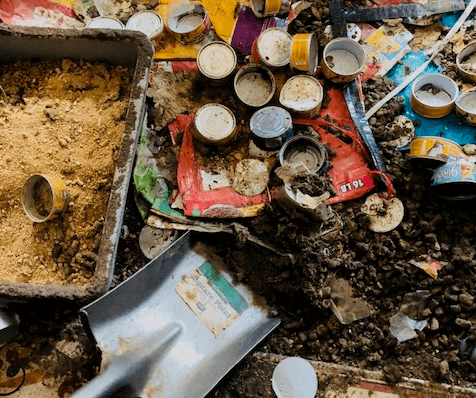
Animal hoarding occurs in communities across the U.S. and researchers estimate that hoarding accounts for the suffering and death of over 250,000 animals each year. For instance, if you search the news section on Google for “Animal Hoarding” you will find recent stories all over the U.S.
Most recently, we’ve seen:
These dire conditions cause immense suffering for both animals and people, while overwhelming local animal shelters. So how can you help? The first step, is education.
In this post, we’ll answer and provide resources to common animal hoarding questions.
What is considered animal hoarding?
According to the ASPCA, the following criteria are used to define animal hoarding:
What causes animal hoarding?
Often, the behavior of animal hoarding begins after an illness, disability, or difficult life event. In most situations, the owner sees the animals as a major source of love, and they have the best of intentions of caring for their animals. However, overtime they become overwhelmed and unable to make decisions which leads to unintentional neglect or abuse.
The Anxiety & Depression Association of America (ADAA) states that hoarders also have an intense emotional attachment to their animals. They avoid the pain of letting go of things that seem very special, even when clutter prevents comfortable living. Like object hoarders, animal hoarders believe that things should be saved for some special event, even if the event never happens. They imagine the wonderful way in which they will heal love, and nurture their pets, while overlooking the terrible effects of having too many of them.
“The sometimes hundreds of dog or cat victims of a single hoarder generally show signs of abuse such as severe malnutrition, untreated medical conditions including open sores, cancers, and advanced dental and eye diseases, and severe psychological distress.” - Animal Legal Defense Fund
Who is most likely to hoard animals?
The Hoarding of Animals Research Consortium reviewed the case records of 71 incidents from across the United States and Canada to determine what characterizes a typical animal hoarding case. Of the cases reviewed, here’s what they discovered:
There are also commonalities in the living environment. Often essential utilities and major appliances such as showers, heaters, stoves, toilets, and sinks were not functional. 70% of the homes had fire hazards and 16% of the residences were condemned as unfit for human habitation.
At Bio-One, the circumstances as described in the research findings above are common for our teams. Animal waste can be unsafe when not properly contained and regularly cleaned, as well as human urine and feces. Learn more about Bio-One’s hoarding services.
What happens to animals after they are rescued?
Sue Marue the founder of the Arizona based cat rescue Ark Cat Sanctuary, spoke with our Bio-One Mesa, AZ team and said:
We have taken in dozens and dozens of cats from all over Arizona that have been rescued from hoarders. The lucky ones can be up for adoption within weeks. But for some, they will never be ready for adoption and will live out their days at Ark or we cannot save them because they are just too sick. We have one little tabby that we rescued from a hoarder in Phoenix over a year ago that just last week allowed us to pet her and love her. Sometimes it takes that long. The problem with that is most rescues cannot take a year for an animal to come around. They don't have that kind of space or time. It isn't their fault, it is just how it is. We deal with overpopulation, under-funding and just not enough help. Unfortunately, it’s the animals that suffer.
Bio-One animal hoarding case study
In a 2018 blog post, the Bio-One team in Orlando described circumstances that led their team to remediating an animal hoarding situation:
“Bio-One cleaned out a home in Polk County, Florida, when a Hoarder was discovered by pure coincidence. The Hoarder was to be evicted from the rental property due to nonpayment. The local Sherriff's office came to evict him from the property and this was when the situation of Hoarding was discovered. He had been hoarding many dogs within the home and living in deplorable conditions. Animal Control came out and confiscated the animals. The Hoarder was taken into custody at the moment of discovery. The whole situation was incredibly sad and ultimately could have been avoided...”
Read the entire story on their blog.
How Can You Help?
The most immediate ways to make in impact in your community is to contact your local animal rescue to make a donation or volunteer your time. Also, if you see an animal in distress, contact your local authorities.
If you think someone you know is struggling with animal hoarding, ASPCA.org lists important steps to ensure the animals are quickly helped and the hoarder receives the support they require.
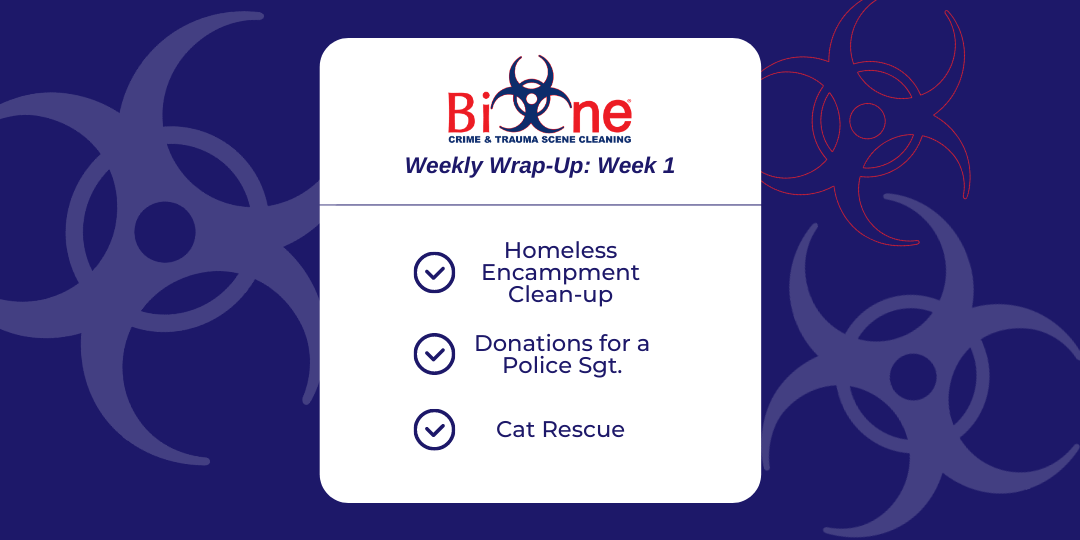
Bio-One teams across the U.S. answer calls to help their communities and remediate a variety of scenes. In our new blog series, we'd like to bring you into the Bio-One world by sharing stories of the unique and important work we do for local communities.
Here is Week 1 of our Bio-One Weekly Wrap-Up.
Homeless Encampment Clean-Up - Temecula, CA
On the west coat, the Bio-One team was called by the Hemet San Jacinto Chamber of Commerce to safely decontaminate an area outside their office. With homelessness on the rise, there is in increase of biohazardous waste that is sadly starting to accumulate in zones of our cities.
While Bio-One teams have been actively remediating homeless encampments for decades, we just refreshed this information on our Bio-One website. View it here.
"We are actively looking for partnerships to help keep our cities clean and safe for children and families." - Jason and William, Bio-One Owners
COVID-19 Disinfection to Raise Money for Local Police Sgt. - Asheville, NC
In the fall of 2020, it was announced that Jax, the 3 year-old son of Sgt. Jordan Warren at the Henderson County Sheriff's Office, was diagnosed with an aggressive form of cancer. Sgt. Warren has served the community in Henderson County for 10 years, and the community has rallied on his behalf by donating thousands of dollars for the family in their time of need.
To help raise money, the Bio-One team in Asheville raffled off a COVID-19 disinfection, up to 5,000 sqft for any home or business. The raffle ran through January 2021 and raised over $600. This week, the team happily treated the winner, Strong Hand Fitness, to the disinfection.
"Police officers and their families make big sacrifices to serve their community, most of which go unseen. So, when first responder families are in need, we want to help anyway we can. We wish the entire Warren family the best as Jax continues his fight." - Matt Gregg, Bio-One Owner
Cat Rescue - Flagstaff, Arizona
In January, the Bio-One team in Flagstaff answered the call to remediate an unattended death. They learned from the next of kin that a husband had passed away in the home while his wife, at the time, was fighting for her life at the local hospital after being diagnosed with COVID-19.
Once the team arrived, it was clear this would be a multi-day job. Not only was there a biohazard to remediate, but the home was hoarded and restoring the home to a safe environment was an urgent need. While working, the Bio-One crew identified three cats lingering in and around the home. Initially, it was assumed one cat was owned by the family, and the other two were part of the neighborhood. The first cat, nicknamed Hunter, was given to the Ark Cat Sanctuary for a checkup and to eventually find a new home. In the spirit of kindness, the team also provided food and water for the other two neighborhood cats when working onsite.
Several weeks passed, and the Bio-One team received word that the wife had sadly lost her life due to complications from COVID-19. The next of kin asked the team to revisit the home and remove remaining items. Shortly after work began, the two neighborhood cats were found. It was then revealed that the two animals were owned by the deceased couple. After living off the land for months, they were rescued by the Bio-One team and turned over to the Ark Cat Sanctuary for care. We hope each animal finds a loving home.
"We are very fortunate that our staff and owners have a heart for animals and will do whatever they can to help the pets like we do our clients." - Rebecca Wallace, Bio-One Owner